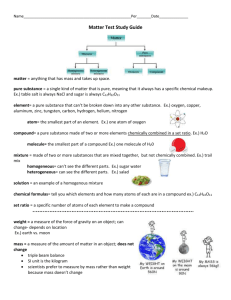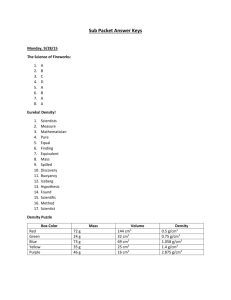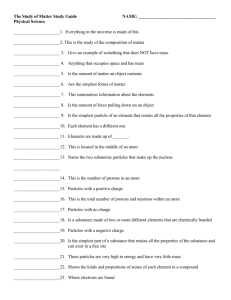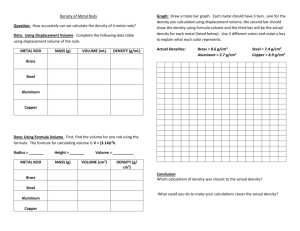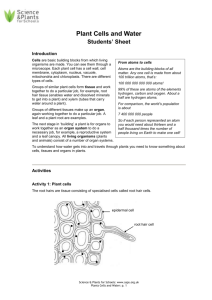Name Objective 1: Matter and Energy C3H8 + 5O2 → 3CO2 + 4H2O
advertisement
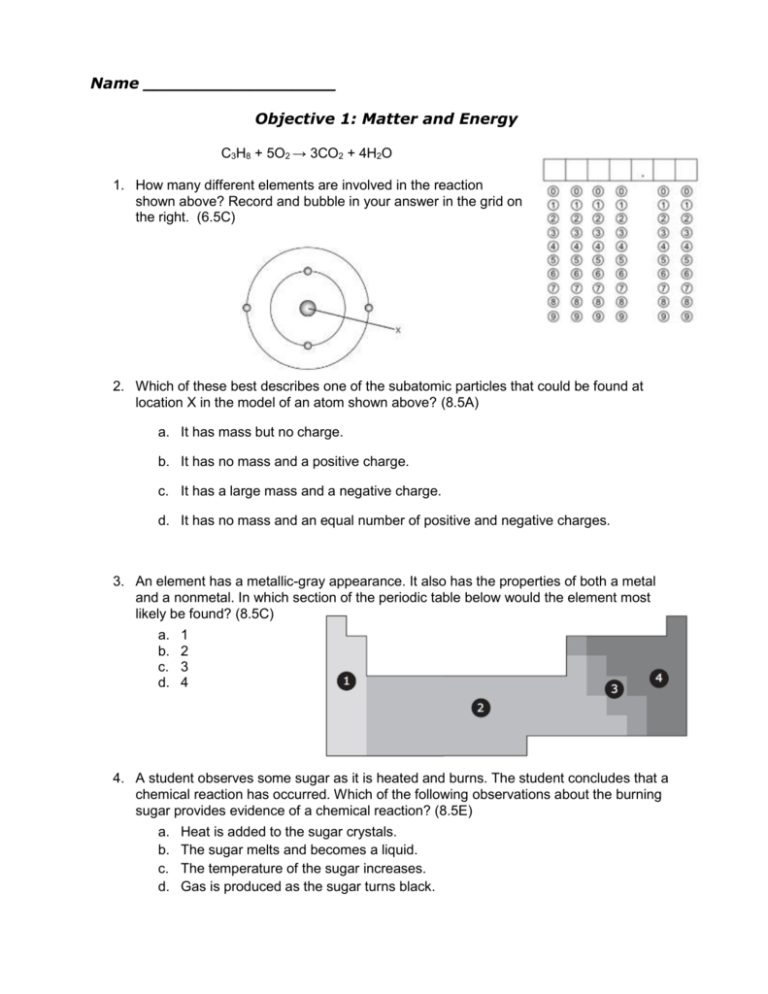
Name __________________ Objective 1: Matter and Energy C3H8 + 5O2 → 3CO2 + 4H2O 1. How many different elements are involved in the reaction shown above? Record and bubble in your answer in the grid on the right. (6.5C) 2. Which of these best describes one of the subatomic particles that could be found at location X in the model of an atom shown above? (8.5A) a. It has mass but no charge. b. It has no mass and a positive charge. c. It has a large mass and a negative charge. d. It has no mass and an equal number of positive and negative charges. 3. An element has a metallic-gray appearance. It also has the properties of both a metal and a nonmetal. In which section of the periodic table below would the element most likely be found? (8.5C) a. b. c. d. 1 2 3 4 4. A student observes some sugar as it is heated and burns. The student concludes that a chemical reaction has occurred. Which of the following observations about the burning sugar provides evidence of a chemical reaction? (8.5E) a. b. c. d. Heat is added to the sugar crystals. The sugar melts and becomes a liquid. The temperature of the sugar increases. Gas is produced as the sugar turns black. 5. Which of the following could be the chemical formula for sulfuric acid? (8.5D) a. HSO b. HSO4 c. H2SO4 d. HS2O4 6. All the following chemical equations are balanced except — (8.5F) a. C3H8 + O2 → 3CO2 + 4H2O b. RbBr + AgCl → AgBr + RbCl c. WO3 + 3H2 → W + 3H2O d. Zn + 2HCl → ZnCl2 + H2 Zn + 2HCl → ZnCl2 + H2 7. Based on the reaction shown above, which statement best supports the law of conservation of mass? (8.5F) a. There are more chlorine atoms in the reactant. b. There are more hydrogen atoms in the product. c. The number of chlorine atoms is unequal in the reactants and products. d. The number of reactant atoms is equal to the number of product atoms. 8. All of the following elements are metals except — (8.5C) a. lead b. iron c. gold d. silicon 9. An atom of an element contains 20 protons. What is the identity of the element? (8.5B) a. Argon b. Calcium c. Neon d. Potassium 10. Elements are arranged in the Periodic Table based on their properties in a particular order. Which of the following best identifies the period and group of the elements listed? (8.5C) a. b. c. d. 11. In the chemical equation, the elements are rearranged to form new products. Which of the following compounds should be placed in the box? (8.5E) a. CO2 b. H2O c. Co d. CaCl2 12. Which table best summarizes the subatomic particles and their electrical charge? (8.5A) a. b. c. d. 13. Which of the following elements is malleable? (6.6A) a. Iron b. Hydrogen c. Carbon d. Sulfur 14. Which subatomic particle determines the identity of an element? (8.5B) a. Nucleus b. Electron c. Neutron d. Proton 15. How many elements are found in 2H2SO4? (6.5C) a. 2 b. 3 c. 7 d. 14 16. Which two compounds contain the same total number of atoms? (8.5D) a. C3H8 and C2H6 b. NO2 and KCl c. 2Li2S and Be4Cl2 d. 2CO and CO2 17. All of the following are indicators of a chemical change except — (8.5E) a. formation of a gas b. change in temperature c. change in the state of matter d. formation of a precipitate 18. Why is the compound CaH10P4K3O4 an inorganic compound? (7.6A) a. The compound does not contain the element carbon b. The compound contains too many elements c. The compound contains 5 elements d. The compound contains 22 atoms 19. Which of the following elements is found in all organic compounds? (7.6A) a. Argon b. Carbon c. Neon d. Potassium 20. When you chew, the particles of food are broken down before they are swallowed. How would you describe this kind of change? (7.6B) a. A physical change because swallowing is a physical motion b. Both a physical and chemical change because food starts being digested before it is swallowed c. A chemical change because the particles of food get mixed together d. A physical change because the particles of food are getting smaller 21. Which of the following is an example of a chemical change related to digestion? (7.6B) a. Stomach acid breaking down food particles to form carbohydrates b. Muscles moving your food from your mouth into your stomach c. Teeth chewing on a bite of a sandwich until it is small enough to swallow d. A knife slicing a tomato into quarters 22. A piece of a substance has a volume of 6.7 cm3 and mass of 75.7 g. Using the chart, what is the identity of the substance, its classification, and its density? (6.6B) a. b. c. d. 5.32 g/cm3; germanium; metalloid 7.87 g/cm3; iron; metal 11.3 g/cm3; lead; metal 13.6 g/cm3; mercury; metal 23. Which of the following tables would be used to correctly describe the difference between metals and non-metals? (6.6A) a. b. c. d. 24. If an element is shiny, can be hammered into thin sheets, and is a good conductor of electricity, what type of element is it? (6.6A) a. A metal b. A metalloid c. A non-metal d. A gas 25. The following table shows the properties of four different sample materials. One of these materials is cork, a type of wood that floats on water (density of water = 1.00 g/cm3). What is the density of cork in g/cm3? Fill you answer in the grid below.(6.6B)
